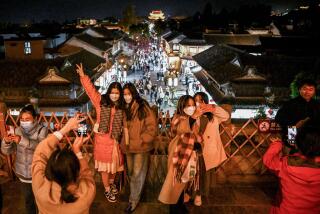Detroit of China Surrounded by Backwater of Poverty : Asia: The arrival of the 20th Century proves to be a blessing only for some.
- Share via
SHIYAN, China — Mules pull the loads and there’s hardly a car to be seen in Motor City, China.
This city of 378,000 in the mountains of central China is home to the Second Automobile Works, the nation’s largest truck manufacturer, which employs 80,000 people and indirectly provides livelihoods for many more.
It made 135,000 trucks last year, about one-fourth of all the motor vehicles China produced.
The Second Automobile Works has brought the 20th Century, and prosperity, to a backwater where peasants still use mules and water buffalo to scratch a living from the rocky terrain.
When China was in the throes of the Cultural Revolution in the late 1960s and relations with the Soviet Union were extremely tense, Mao Tse-tung decided to move key industries out of the way of upheaval and invasion.
In 1969, it was decided that trucks would be made in Shiyan, a small town in the poverty belt of northwest Hubei province.
“There was nothing here but rice paddies then,” said Ma Yue, executive vice president of the plant, who arrived in 1971. “There was no place to live, so we had to stay with farmers.”
Young men brought in as workers had difficulty finding wives, so a textile mill was built to attract young women.
Today, per capita annual income is about 2,800 yuan ($595) for workers at the truck plant and 2,300 yuan ($489) for Shiyan residents in general. Both are roughly double the national average.
Trucks from the Second Automobile Works are in great demand--all 140,000 vehicles to be made this year are already sold--so Shiyan has escaped an economic slump that began affecting most of China six months ago. The city’s industrial output in the first four months of 1990 grew by 5.1%.
Unemployment is a problem in China as a whole, but not in Shiyan. Because the area is so remote, the truck plant relies on local sources for 70% of its parts.
Company officials also say the state-run enterprise will not lay off workers as it automates, although the factory appears overstaffed.
During a visit to the final assembly plant, 146 people were working along a 785-foot production line. Children of workers are usually guaranteed jobs at the plant.
Shiyan has shown off its affluence by building a musically synchronized fountain, costing the equivalent of $170,000, that provides residents with a colorful water symphony every weekend.
Mayor Wu Fayu said that by supporting the truck factory and “marching along the socialist road,” the people of his city are “leading a comfortable life.”
Poverty still reigns outside the city. Beyond the drab, functional apartments for factory workers, farmers hack at tiny vegetable patches next to one-room huts of brick and mud.
Water buffalo pull plows through rocky soil. Women wash clothes in streams while their children bathe.
After leaving Shiyan, the road quickly deteriorates into potholes and stretches of construction, where young boys chip at the mountainsides with pickaxes.
Buses, jeeps and trucks cruise on the city’s wide, empty streets, but there are virtually no passenger cars. Carts pulled by men or mules carry produce and supplies.
The few traffic lights in Shiyan were turned off during a recent visit to Shiyan. Street lights on a main avenue did not come on after dark and couples strolled down the middle of the moonlit street.
Guo Shuyan, the provincial governor, said northwest Hubei is so remote that the government did not know of a serious food shortage in one area until a newspaper reporter wrote an expose. He said authorities quickly sent 44,000 tons of grain.
Company officials acknowledge that being more than 600 miles inland from Shanghai is a drawback to competing in the expanding Chinese auto industry.
“We are in the mountains, so we have to provide our own schools and welfare facilities,” Ma said. About 10% of the 1989 profit of 600 million yuan ($127 million) went to welfare programs.
Asked about the original decision to build the plant in Shiyan, Ma replied: “It was the 1960s, and we had no choice.”
Shiyan will remain the company’s base, but it has ambitious plans and is looking elsewhere.
A joint venture with Citroen of France to produce 150,000 small passenger cars annually by 1993, and up to 300,000 later, will be built in Wuhan, the Hubei provincial capital. Wuhan is on the Yangtze River, an ideal route for shipping finished cars.
Xiangfan, on the plains 120 miles east of Shiyan, will be the site of a plant to produce up to 400,000 engines a year for the joint venture.
More to Read
Sign up for Essential California
The most important California stories and recommendations in your inbox every morning.
You may occasionally receive promotional content from the Los Angeles Times.










